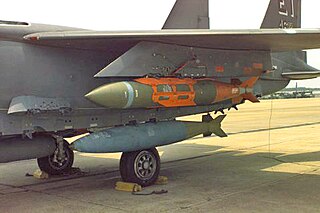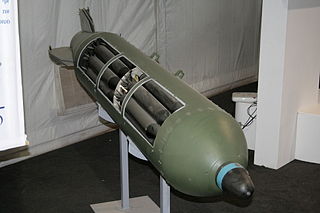
A bomb is an explosive weapon that uses the exothermic reaction of an explosive material to provide an extremely sudden and violent release of energy. Detonations inflict damage principally through ground- and atmosphere-transmitted mechanical stress, the impact and penetration of pressure-driven projectiles, pressure damage, and explosion-generated effects. Bombs have been utilized since the 11th century starting in East Asia.
Durandal or Durendal is the legendary sword of the French hero Roland.
The GBU-28 is a 4,000-pound (1,800 kg) class laser-guided "bunker busting" bomb produced originally by the Watervliet Arsenal, Watervliet, New York. It was designed, manufactured, and deployed in less than three weeks due to an urgent need during Operation Desert Storm to penetrate hardened Iraqi command centers located deep underground. Only two of the weapons were dropped in Desert Storm, both by F-111Fs. One GBU-28 was dropped during Operation Iraqi Freedom. It was designed by Albert L. Weimorts.
The Mark 84 or BLU-117 is a 2,000-pound (900 kg) American general-purpose bomb. It is the largest of the Mark 80 series of weapons. Entering service during the Vietnam War, it became a commonly used US heavy unguided bomb. At the time, it was the third largest bomb by weight in the US inventory behind the 15,000-pound (6,800 kg) BLU-82 "Daisy Cutter" and the 3,000-pound (1,400 kg) M118 "demolition" bomb. It is currently sixth in size due to the addition of the 5,000 lb (2,300 kg) GBU-28 in 1991, the 22,600 lb (10,300 kg) GBU-43/B Massive Ordnance Air Blast bomb (MOAB) in 2003, and the 30,000 lb (14,000 kg) Massive Ordnance Penetrator.

The Storm Shadow is a Franco-British low-observable, long-range air-launched cruise missile developed since 1994 by Matra and British Aerospace, and now manufactured by MBDA. "Storm Shadow" is the weapon's British name; in France it is called SCALP-EG. The missile is based on the French-developed Apache anti-runway cruise missile, but differs in that it carries a unitary warhead instead of cluster munitions.

The Arme Planante À Charges Éjectables or Apache is a French-developed, air-launched, anti-runway cruise missile manufactured by MBDA France. The SCALP EG missile is based on it, notably featuring similar aerodynamics and stealth. However, the latter has a different propulsion system and carries a single high-penetration warhead instead of the Apache's cluster submunitions.

The Dassault Mirage 2000 is a French multirole, single-engine, delta wing, fourth-generation jet fighter manufactured by Dassault Aviation. It was designed in the late 1970s as a lightweight fighter to replace the Mirage III for the French Air Force. The Mirage 2000 evolved into a multirole aircraft with several variants developed, with sales to a number of nations. It was later developed into the Mirage 2000N and 2000D strike variants, the improved Mirage 2000-5, and several export variants. Over 600 aircraft were built and it has been in service with nine nations.

The Exocet is a French-built anti-ship missile whose various versions can be launched from surface vessels, submarines, helicopters and fixed-wing aircraft.

The MICA is a French anti-air multi-target, all weather, fire-and-forget short and medium-range missile system manufactured by MBDA France. Its name is an abbreviation of Missile d'Interception, de Combat et d'Auto-défense. It is intended for use both by air platforms as individual missiles as well as ground units and ships, which can be equipped with the rapid fire MICA Vertical Launch System. It is fitted with a thrust vector control (TVC) system. It was developed from 1982 onward by Matra. The first trials occurred in 1991, and the missile was commissioned in 1996 to equip the Rafale and Mirage 2000. It is a replacement for both the Super 530 in the interception role and the Magic II in the dogfighting role.

The air-sol moyenne portée is a French nuclear air-launched cruise missile manufactured by MBDA France. In French nuclear doctrine, it is referred to as a "pre-strategic" weapon, the last-resort "warning shot" prior to a full-scale employment of strategic nuclear weapons launched from the Triomphant-class ballistic missile submarines. The missile's development was undertaken by Aérospatiale's Tactical Missile Division, now part of MBDA.

The BLU-109/B is a hardened bunker buster penetration bomb used by the United States Air Force. As with other "bunker busters", it is intended to penetrate concrete shelters and other hardened structures before exploding. In addition to the US, it is part of the armament of the air forces of Australia, Belgium, Canada, Denmark, France, Germany, Greece, Italy, Israel, Netherlands, Norway, Pakistan, Saudi Arabia, United Kingdom and United Arab Emirates.

Anti-runway penetration bombs are explosive weapons involving bombs or bomblets designed to damage or destroy runways, or otherwise render them unusable for aircraft.
Offensive counter-air(OCA) is a military term for the suppression of an enemy's military air power, primarily through ground attacks targeting enemy air bases: disabling or destroying parked aircraft, runways, fuel facilities, hangars, air traffic control facilities and other aviation infrastructure. Ground munitions like bombs are typically less expensive than more sophisticated air-to-air munitions, and a single ground munition can destroy or disable multiple aircraft in a very short time whereas aircraft already flying must typically be shot down one at a time. Enemy aircraft already flying also represent an imminent threat as they can usually fire back, and therefore destroying them before they can take off minimizes the risk to friendly aircraft.

The JP233, originally known as the Low-Altitude Airfield Attack System (LAAAS), is a British submunition delivery system. It consists of large dispenser pods carrying several hundred submunitions designed to attack runways.

The National Engineering & Scientific Commission (NESCOM) is a Pakistani government-funded defense contractor that develops, designs and sells defense hardware, including missile and weapon systems. It was funded and formed by the Government of Pakistan to develop its domestic production of weapon system.

The Otomat is an anti-ship and coastal defence missile developed by the Italian company Oto Melara jointly with Matra and now made by MBDA. The name comes, for the first versions, from the name of the two builders and, for the later versions, Teseo, from the Italian word for Theseus. The MILAS variant is an anti-submarine missile. In its latest version Mk/2E purchased by the Italian Navy is a medium range anti-ship missile and a ground attack missile.
TDW is a European company that develops and manufactures warheads for guided weapons. The company was founded in 1994 and has 130 employees based in Schrobenhausen, Germany. TDW is a 100% subsidiary of MBDA Deutschland GmbH and part of the European guided weapon group MBDA.

The MW-1 is a German munitions dispenser similar to the British JP233. It is designed to be carried on the Tornado IDS, although it can be carried on the Lockheed F-104 Starfighter and the McDonnell Douglas F-4 Phantom II. The MW-1 started to be phased out after the German Government ratified the Convention on Cluster Munitions in 2009.
The BAP 100 is a French anti-runway cluster bomb developed in the mid-1970s, and which entered service with the French Air Force in the early 1980s. The bomb consists of eighteen submunitions, arranged in a cluster. Accelerated by an internal propulsion system, the munitions are designed to ensure total runway destruction in a single pass by aircraft.















